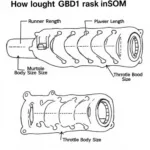OBD2 car reader codes, those cryptic combinations of letters and numbers that appear on your OBD2 scanner, might seem like a foreign language at first. However, understanding these codes is key to unlocking valuable information about your car’s health and performance. Whether you’re a seasoned mechanic or a car enthusiast, this comprehensive guide will equip you with the knowledge to decipher OBD2 codes and take control of your vehicle’s maintenance.
What are OBD2 Car Reader Codes?
Essentially, OBD2 codes are your car’s way of communicating with you. When your car’s computer system, also known as the Engine Control Unit (ECU), detects a problem, it generates a specific code that corresponds to the issue. This code is then stored in the ECU’s memory and can be accessed using an OBD2 scanner.
Types of OBD2 Codes
OBD2 codes are categorized into four main types:
- P Codes (Powertrain): These codes relate to the engine, transmission, and emission control systems.
- B Codes (Body): These codes cover issues with the body electronics, such as airbags, power windows, and central locking.
- C Codes (Chassis): These codes diagnose problems with the chassis components like the ABS, traction control, and suspension.
- U Codes (Network & Communication): These codes indicate faults in the communication network between the various control modules in the vehicle.
Each code consists of a letter and four digits. For instance, a “P0301” code signifies a misfire detected in cylinder number one.
Common OBD2 Car Reader Codes and Their Meanings
While there are thousands of potential OBD2 codes, some appear more frequently than others. Here are a few common examples:
- P0420: Catalyst System Efficiency Below Threshold (Bank 1) – This code often indicates a failing catalytic converter.
- P0171: System Too Lean (Bank 1) – This code suggests that the engine is running lean, meaning there is too much air or not enough fuel in the air/fuel mixture.
- P0300: Random/Multiple Cylinder Misfire Detected – This code points to an engine misfire that is occurring randomly across multiple cylinders.
- P0135: O2 Sensor Heater Circuit Malfunction (Bank 1, Sensor 1) – This code indicates a problem with the heating element in the upstream oxygen sensor.
- P0440: Evaporative Emission Control System Malfunction – This code suggests a leak in the evaporative emissions system, which is responsible for capturing fuel vapors from the fuel tank.
How to Use an OBD2 Car Reader
Using an OBD2 scanner is a straightforward process. Here’s a step-by-step guide:
- Locate the OBD2 port: The OBD2 port is typically found under the driver’s side dashboard.
- Connect the OBD2 scanner: Plug the scanner into the OBD2 port.
- Turn on the ignition: Turn the ignition key to the “on” position, but don’t start the engine.
- Read the codes: The OBD2 scanner will display any stored codes. Note down the codes and their descriptions.
- Clear the codes: Once you’ve addressed the underlying issue, you can use the scanner to clear the codes.
Important Note: While an OBD2 scanner can help you identify potential car problems, it’s essential to consult with a qualified mechanic for a proper diagnosis and repair.
Benefits of Using an OBD2 Car Reader
Owning an OBD2 car reader can offer several benefits, including:
- Early Problem Detection: Identifying issues early can prevent costly repairs down the line.
- DIY Diagnostics: You can troubleshoot basic car problems yourself, saving money on mechanic visits.
- Improved Fuel Efficiency: Addressing engine performance issues can improve your car’s fuel economy.
- Peace of Mind: Knowing the status of your car’s health can provide valuable peace of mind.
Choosing the Right OBD2 Car Reader
With a wide range of OBD2 car readers available, choosing the right one can seem daunting. Here are some factors to consider:
- Compatibility: Ensure the scanner is compatible with your car’s make and model.
- Features: Basic scanners read and clear codes, while more advanced models offer live data streaming, graphing capabilities, and manufacturer-specific code definitions.
- Ease of Use: Look for a scanner with a user-friendly interface and clear instructions.
Conclusion
Understanding OBD2 car reader codes empowers you to take a proactive approach to your car’s maintenance. By familiarizing yourself with these codes and investing in a reliable OBD2 scanner, you can gain valuable insights into your car’s health, identify potential issues early on, and make informed decisions about repairs.
Frequently Asked Questions about OBD2 Car Reader Codes
- Can I drive my car with an OBD2 code?
While it’s generally safe to drive short distances with certain OBD2 codes, it’s crucial to address the underlying issue promptly to prevent further damage and ensure your safety. - Will disconnecting the battery reset OBD2 codes?
Yes, disconnecting the battery for a period can clear OBD2 codes. However, this is only a temporary solution and won’t address the root cause of the problem. - Do I need a professional to use an OBD2 scanner?
No, basic OBD2 scanners are user-friendly and can be used by anyone. However, interpreting the codes and diagnosing the problem often requires mechanical expertise. - How often should I check my car for OBD2 codes?
It’s a good practice to check for OBD2 codes periodically, especially if you notice any unusual performance issues with your car. - Where can I find more information about specific OBD2 codes?
You can find detailed information about specific OBD2 codes online or in automotive repair manuals.
If you need assistance with understanding OBD2 codes or require any car diagnostic services, please don’t hesitate to contact us via WhatsApp: +1(641)206-8880 or email: [email protected]. Our team of expert technicians is available 24/7 to assist you.

